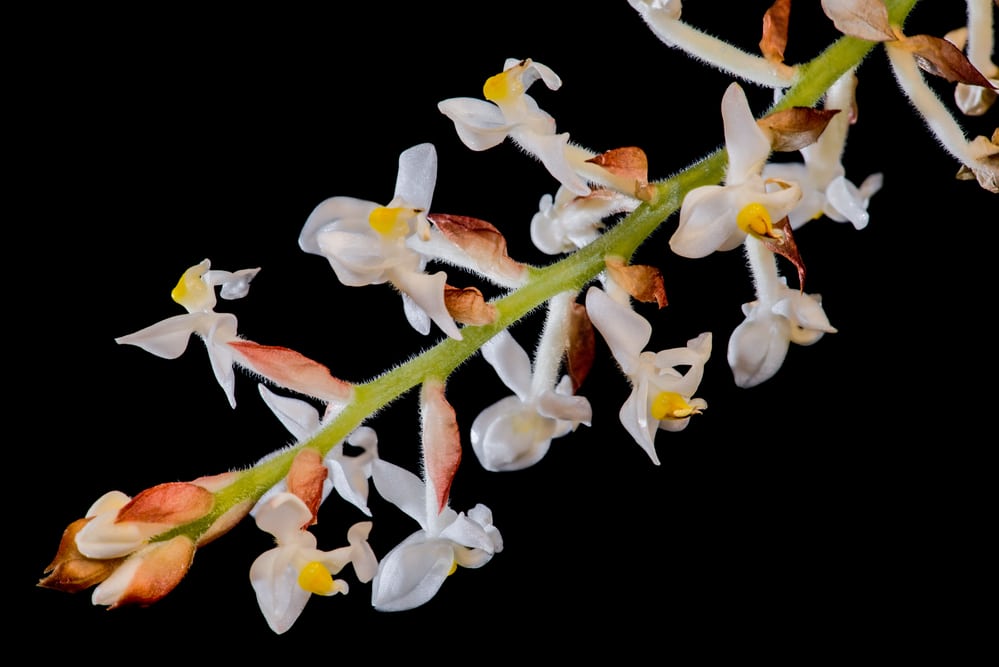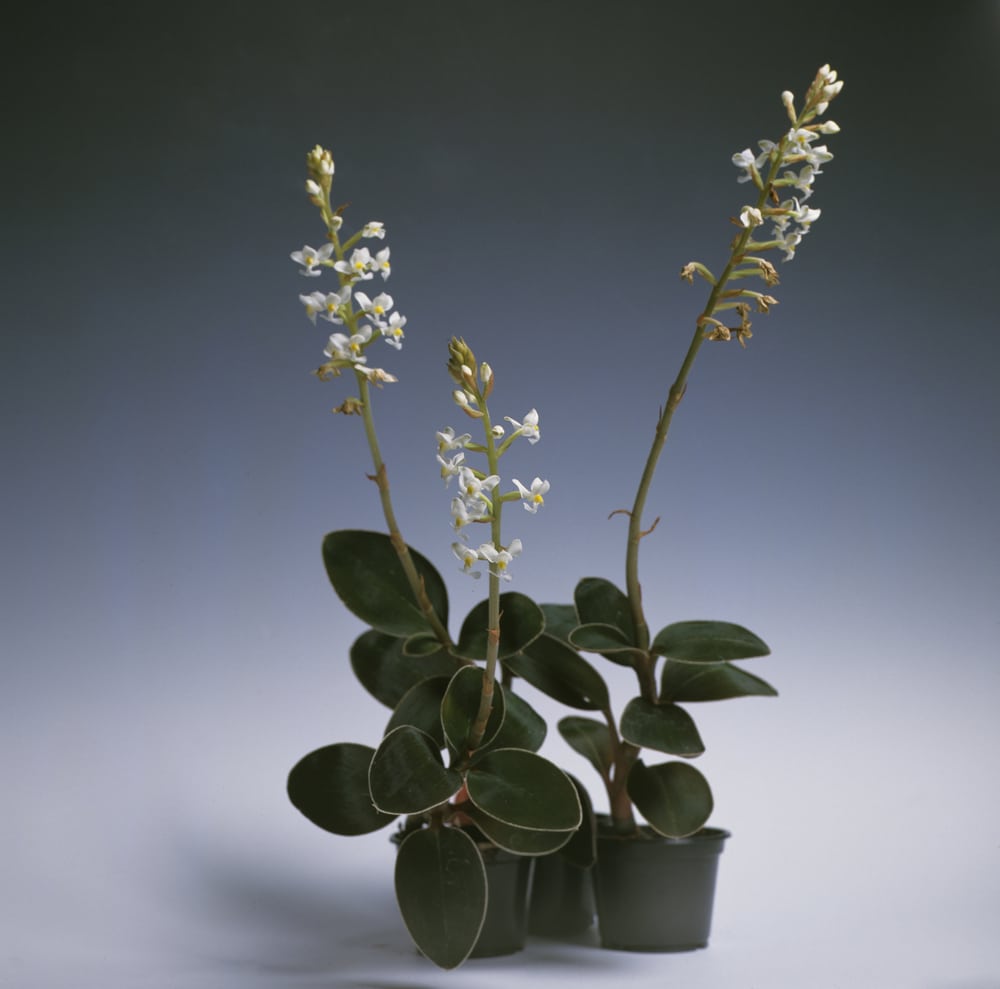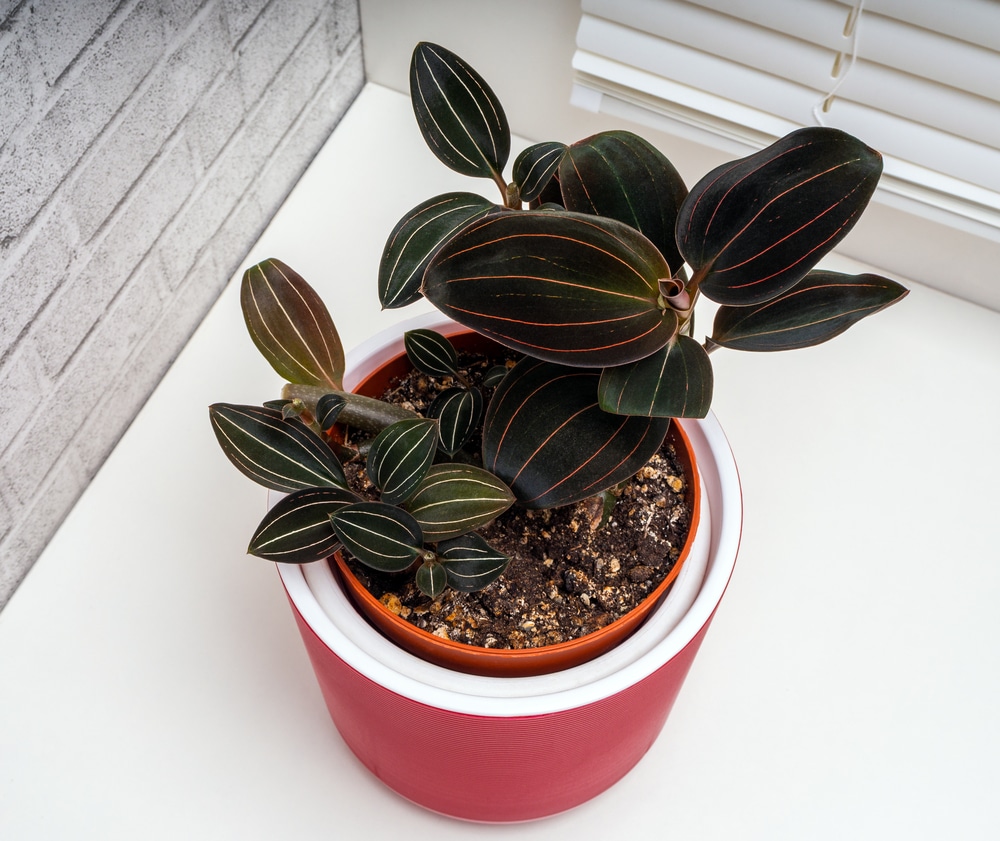When we think of orchids, we likely imagine their vibrant, ostentatious inflorescences teetering high above modest foliage. But the Jewel Orchid is different. Easily distinguishable from conventional orchids, they are cultivated mainly for their striking swarthy foliage rather than their blooms. Despite their dark and dramatic appearance, Jewel Orchids are surprisingly laid-back and tolerant houseplants which are sure to make an intriguing addition to any houseplant collection.
Origin and History
Native to tropical areas of Southeast Asia, Malaysia, and the Pacific Islands, the Jewel Orchid genus Ludisia, was originally thought to be monotypic, containing just one species, the Ludisia discolor. In 2013, however, scientists discovered a new species Ludisia ravenii in the Philippines. Unlike most orchids, which are epiphytic and grow from other plants or trees, the Jewel Orchid is terrestrial, meaning it grows from soil. In its native habitat it extends laterally from the heavily shaded and humid forest floor, far beneath the canopy.
The Jewel Orchid has a rather confusing history. It was first recorded in the Botanical Register of 1818 under the genus name Goodyera discolor. In 1825 it was correctly reclassified under the Orchid family genus as Ludisia, however, in 1840 it was once again reclassified, this time as Haemaria. It wasn’t until 1970 that the Jewel Orchid classification was finally correctly reassigned to the Ludisia genus in the Kew Bulletin.

Appearance
Distinct from more conventional orchid varieties, typically prized for their flamboyant, complex, and opulent inflorescences, the Jewel Orchid is cultivated largely for its dramatic, decorative, and somewhat rigid foliage protruding from stocky, knobbly, stems. The leaves are around two to three inches long with a velvety, suede-like texture, and come in a spectrum of saturnine colors, from deep green to maroon, to almost-black. The deep-hued leaves are embellished with complex networks of contrasting vein-like stripes, usually red or yellow in hue, which create ornate patterns. The foliage has a faintly shimmering appearance which inspires its name ‘Jewel’ orchid. Whilst it is certainly most adored for its foliage, the Jewel Orchid does produce pretty winter inflorescences of delicate off-white petals, in striking polarity to its dark and dramatic foliage.
Care Guide
In this section we cover important Jewel Orchids care topics such as light, water, fertilizing, repotting, and more.
Growth Habit
Jewel Orchids are fairly slow-growing. Unlike other orchids, Ludisia Discolor tends to expand horizontally rather than vertically, resulting in a plant that is about as wide as it is tall, with an ultimate spread of around 15 – 20 inches. It will usually take between two to five years to reach a full height of around 20 inches. During flowering, however, Jewels will extend long vertical spikes which can reach up to 24 inches tall, often doubling their height, on which the flowers perch.
Light
They are used to heavy shade in their natural habitat of the rainforest floor, so Jewel Orchids are tolerant of extremely low light levels. Despite this, a few hours per day of moderate, indirect sunlight is desired for best growth and health, so positions in north-facing rooms and windows are perfect for this plant. You should avoid direct or prolonged periods of sunlight as this will scorch the leaves and reduce chlorophyll levels, causing its trademark dark foliage to fade.
Watering
Jewel Orchids prefer evenly moist soil like that of the rainforest floor. You should give your Jewel a good soaking every seven to ten days. Allow the soil to drain well and be sure to remove any excess or standing water from the bottom of the pot to avoid wet feet and root rot. You should wait until the top inch of soil has dried out between waterings, but don’t allow all of the the soil to dry out completely.
These plants are sensitive to temperature so use room-temperature water to avoid shocking your plant, especially whilst it is flowering. Under-watering your Jewel Orchid during the growing season can cause it to become dormant prematurely and it may not flower. During winter when your Jewel is not actively growing or flowering, you can reduce watering significantly.
Temperature and Humidity
Used to the warm, moist conditions in its native tropical habitats, your Jewel Orchid will appreciate moderate humidity levels of around 50-60%. They are tolerant of average room humidity but may need misting during the winter when the air is dryer. Pebble trays are a great way to maintain stable humidity levels, just ensure that your pot sits safely above the water line and not in it.
Your Jewel will prefer room temperatures of between 60°F and 75°F. Ensure that the ambient temperature does not drop below 50°F, and be mindful not to place your Jewel close to any heating or cooling equipment such as air conditioning units or radiators, as they are sensitive to extreme temperatures.
Soil and Pots
Unlike most orchids, which grow from other fauna, Jewel Orchids grow naturally in soil, so they don’t require a special orchid substrate. In fact, you should avoid bark-based orchid mixes altogether as they will be far too loose to retain the moisture levels that Jewel Orchids require. You can safely use a normal potting mix of around three parts soil to one part perlite. You could also add a little sphagnum moss to the substrate which will help to retain moisture and mimic the soil conditions of the rainforest floor.
Because of their laterally creeping rhizomes, Jewel Orchids are best suited to wide, shallow pots. Make sure that your chosen pot has a drainage hole to avoid wet feet, and if you are using an ornamental outer pot, be sure to pour away any standing water that collects in the bottom.
Fertilizing
Jewel Orchids have fairly undemanding appetites and don’t need a specialist orchid food. Generic houseplant fertilizer will do the job just fine. You should fertilize monthly during the growing season, and increase the frequency to fortnightly during the flowering period. High potassium fertilizers, such as tomato feed, will promote and extend the flowering period. Once your Jewel has finished flowering, you can withhold food throughout the remainder of the winter. Be careful not to over-fertilize as this can scorch the foliage and cause browning of the leaves.
Pruning
For the most part, Jewel Orchids require very little pruning. Dying leaves should be removed periodically to promote new growth. After flowering, you should cut back the spiky stems once the flowers have died. Flowering can also cause the plant to become leggy. If you prefer the foliage to the flowers, you can prune the flowering stems right back as soon as they start to emerge which will redirect energy back into the main body of the plant. Otherwise, there is no need to prune unless your Jewel shows signs of disease.
Repotting
Mature Jewel Orchids will need transferring into a pot around 1-2 inches larger every couple of years, either when their rhizomes become compacted, or when they become unstable and top-heavy above the soil. The best time to do this is in spring at the beginning of the growing season. It’s a good idea to give the old soil a good soaking a few hours before repotting which helps to avoid shocking the roots during the transfer. The stems can be brittle and fragile so take care when handling your Jewel, but don’t worry if any stems do break, you can simply use them for propagation!

Jewel Orchid Propagation
Unlike more conventional orchids, Jewel Orchids are incredibly simple to propagate by taking cuttings from established stems.
- Using sterilized pruning shears, take a stem cutting, ensuring that it has at least one leaf node.
- Submerge the node end either into a container of water, or into sphagnum moss or potting soil, and place in a north-facing window, or an area with bright, indirect light.
- Replace the water regularly and roots should begin to emerge in around six to eight weeks (if propagating in sphagnum moss or potting soil, ensure that the substrate is kept moist).
- Once a small root network has been established, your new Jewel Orchid can be transplanted into a small, wide pot filled with a similar substrate to that of the parent plant.
Jewel Orchid cuttings are relatively self-sufficient and can be left much to their own devices. They don’t require any rooting hormone or additional help to promote new root growth.
Flowers
Although best known for its foliage, mature, healthy Jewel Orchids will produce delicate and dainty floral blooms, usually during the winter, which can last for several weeks. To promote blooms in an established plant, ensure it receives plenty of indirect light, fertilize fortnightly with high potassium feed during the fall, and maintain an adequate and stable level of humidity throughout the growing and flowering season. Proper care and maintenance throughout the year will improve the chances of blooms in the winter.
Pests and Disease
Here are some common pests and diseases to look out for when keeping Jewel Orchids:
Disease
The most common disease for Jewel Orchids is root-rot, where the soil and roots have become oversaturated or left in standing water for prolonged periods. Symptoms of root rot include wilting or yellowing foliage. Unfortunately, an orchid with root rot is generally unsalvageable, although you may be able to propagate from any stems which remain unaffected. To prevent root rot, ensure that your Jewel has adequate drainage and don’t over-water it.
Too much humidity can increase susceptibility to powdery mildew or other fungal diseases, presenting as a whiteish furry or dusty appearance on the foliage. Ensuring sufficient air circulation is the best way to avoid this whilst maintaining adequate humidity. During flowering, avoid misting the inflorescences directly, as this can cause botrytis petal blight.
Pests
Jewel Orchids are susceptible to many of the common houseplant pests such as spider mites, mealybugs, or aphids which will damage the plant by sucking the sap from its leaves. If you notice any signs of infestation like silvery-white flecks on the leaves, you should first isolate your Jewel from other plants. Clean each leaf thoroughly with rubbing alcohol, insecticidal soap, or neem oil to clear any bugs or eggs, and carefully remove any severely infested leaves with sterilized pruning shears. You should continue to clean your Jewel weekly for the next month to ensure that all the bugs have been removed.

Common Questions
Here are a few of the most common questions that we get about Jewel Orchid care:
Is the Jewel Orchid Toxic?
Unlike the majority of orchids, the Jewel variety has no known toxicity to humans or animals, making it a fantastic ornamental houseplant if you share your home with inquisitive pets or children.
Are Jewel Orchids Rare?
Whilst Jewel Orchids are not particularly rare, they are not particularly common either, and are much less well known than their conventional orchid counterparts. They often carry a fairly high price tag which belies both their ease of care and ease of propagation, and gives the impression of rarity.
Troubleshooting
Here are a few common troubleshooting questions regarding Jewel Orchids:
Why are my Jewel Orchid Leaves Drooping?
Too much sunlight can cause your Jewel Orchid to wilt significantly, as can overwatering, particularly if root-rot has begun to take hold. It can also be a sign of pests, so check your plant over for any signs of infestation.
Why are my Jewel Orchid Leaves Yellowing?
As with drooping leaves, yellowing leaves can be caused by several problems. Too much sunlight can cause yellowing leaves, as can overwatering, and, conversely, so can prolonged periods of drought. Yellow leaves can also be a sign that the ambient temperature is too cold for your Jewel Orchid. If you notice yellowing of the leaves, it’s a good idea to do a general health check on the plant and its environment to try to pinpoint the cause.
Why are my Jewel Orchid Leaves Turning Brown and Crispy?
Uncharacteristically dark or dry leaves are usually caused by overexposure to sunlight or periods of drought. You should relocate your Jewel to a more sheltered position. It can also be caused by overfeeding. You can either reduce the feeding frequency or increase the dilution ratio of your chosen fertilizer.
Why is my Jewel Orchid not Flowering?
Jewel Orchids must reach a certain level of maturity before they can produce flowers. Correct care and maintaining suitable ambient conditions during the growing season will encourage your Jewel to flower during the winter. Ensure your Jewel receives plenty of indirect light, humidity, and fortnightly high-potassium feeds. Flowering can be somewhat coerced by reducing the watering frequency in anticipation of the flowering period, allowing the Jewel to become root-bound, and moving the plant to a slightly cooler area to place it under some stress. Increasing stress levels in plants can trick them into thinking that they may be dying, so survival instinct kicks in and they rush to produce flowers and release their seeds in order to continue the species.

